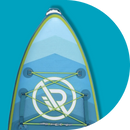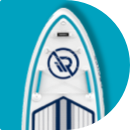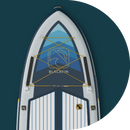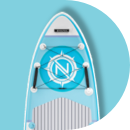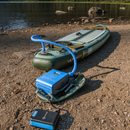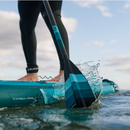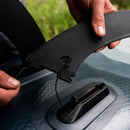What Makes a Location Ideal for Paddle Boarding?

Stand up paddle boarding is a fantastic way to explore waterways and enjoy the outdoors. However, the ideal location for your paddle board adventure can significantly impact your experience. Our article will explore various factors that contribute to the perfect paddle board location, so you can choose the most suitable environment based on your skill level and desired activity.
Whether you seek a calm and scenic cruise or challenging waves, you will need to know what makes a location ideal for a safe and enjoyable paddle experience.
Top 5 Things to Consider for a Perfect Paddle Board Location
Before launching yourself onto the water, consider these top 5 things to transform any body of water into your perfect location paddle board. By acknowledging these factors, you can ensure your chosen spot aligns with your skill level, desired experience, and overall enjoyment.
Water Types
Choosing the ideal paddling location depends on your experience level and desired experience. Here's a breakdown of three popular water types for paddle boarding:

Flat Water
Calm, sheltered bodies of water are ideal for beginners and those seeking a relaxing paddle. Lakes, canals, and protected bays offer flat water with minimal current or wind chop. You will have a stable platform for practicing balance, paddling techniques, and yoga poses on your board.
Flat water environments are also perfect for sightseeing, wildlife watching, and enjoying the tranquility of nature. Paddling on glassy waters at sunrise or sunset can be a truly serene experience.
Moving Water
Moving water encompasses environments with a consistent current, such as slow-moving rivers or canals. They offer a different experience compared to flat water.
The current can add a fitness element to your paddle, providing a workout even on a leisurely outing. Paddling with the current allows you to cover greater distances efficiently while paddling against the current challenges your strength and endurance.
Whitewater
For thrill-seekers, paddling on whitewater presents an exciting challenge. Rivers with rapids offer varying degrees of turbulence, requiring paddlers to navigate currents, waves, and obstacles.
This dynamic environment demands strong paddling skills, good balance, and quick decision-making. Whitewater paddling offers an adrenaline rush and the satisfaction of conquering challenging sections of the river. Important safety precautions must be taken, including wearing a life jacket and helmet and scouting rapids beforehand.
However, not all whitewater experiences are extreme. Some rivers offer sections with milder rapids that are suitable for intermediate paddlers.
Scenic Beauty
A visually stunning backdrop can elevate your paddle board experience from enjoyable to unforgettable. Here's what to consider:

- Variety and Contrast: Look for locations that offer a combination of elements. Calm, sheltered coves are perfect for leisurely paddling, while open water with interesting rock formations or distant islands provides a sense of adventure. Consider a coastline with dramatic cliffs juxtaposed against sandy beaches, or a calm lake surrounded by vibrant autumn foliage.
- Light and Time of Day: Consider how light plays on the landscape. Early mornings often boast a glassy surface and soft light, perfect for capturing breathtaking photos. Conversely, a paddle at sunset can paint the sky in fiery hues, making for a truly magical experience.
Technical Factors to Consider for a SUP Location
Now, let's delve into the technical aspects that make a location the perfect match for your paddle boarding desires.
Accessibility of the Area
Consider how easy it is to get your paddle board to the water's edge.
-
Ease of Entry and Exit: Look for locations with calm, shallow water for easy launching and landing. Sandy beaches or calm coves are ideal, while rocky shores or areas with strong currents can be challenging, especially for beginners.
-
Parking and Amenities: Consider the proximity of parking and restrooms. If you're carrying a paddle board, a long walk from the car can be tiring. Public boat launches with restrooms and changing areas offer a convenient starting point.

Environmental Factors
- Water Cleanliness: Clear water is ideal for stand up paddle boarding (SUP) as it allows you to see potential hazards like submerged objects or uneven terrain. It also enhances the overall experience, allowing you to admire the underwater environment and marine life. Aim for locations with minimal pollution or debris for a safe and enjoyable paddle.
- Wind Speed: Wind speed significantly impacts your SUP adventure. Gentle breezes can be refreshing, but strong winds can create choppy water and make paddling difficult, especially for beginners. Conversely, very calm conditions with no wind can make it challenging to maintain momentum. Look for forecasts with moderate wind speeds, ideally below 10 knots, for a smooth and controlled paddling experience.
- Waves: The size and type of waves significantly impact your paddle boarding experience. Calm, flat water is ideal for beginners and those seeking a relaxing session. Gentle swells can add an element of fun for experienced paddlers. However, large waves or strong currents can be dangerous and should be avoided by inexperienced paddlers.
- Trees: Trees along the shoreline can provide much-needed shade during hot days. Look for locations with a good mix of sun and shade to ensure a comfortable paddling experience. However, be cautious of areas with low-hanging branches or potential hazards like falling debris.
- Sun & Heat: Sun exposure can be a concern during extended paddle boarding sessions. Consider paddling in the early morning or later afternoon to avoid peak sun hours. Opt for locations with shade options, like trees or designated shelters, to take breaks and protect yourself from sunburn.
Pros & Cons of Remote Areas
While the allure of remote areas is undeniable, it's important to weigh the advantages against the potential drawbacks before heading out.
- Pros: Remote locations often boast stunning scenery, pristine water, and minimal crowds. This can be perfect for experienced paddlers seeking a peaceful and immersive experience.
- Cons: Remote areas may lack amenities like washrooms, changing areas, or emergency assistance. Cell phone reception might also be limited. Ensure you plan accordingly, have the necessary safety equipment, and let someone know your paddling route and estimated return time for safety.
Your Paddle Boarding Skill Level
The ideal location for paddle boarding is highly dependent on your skill level.
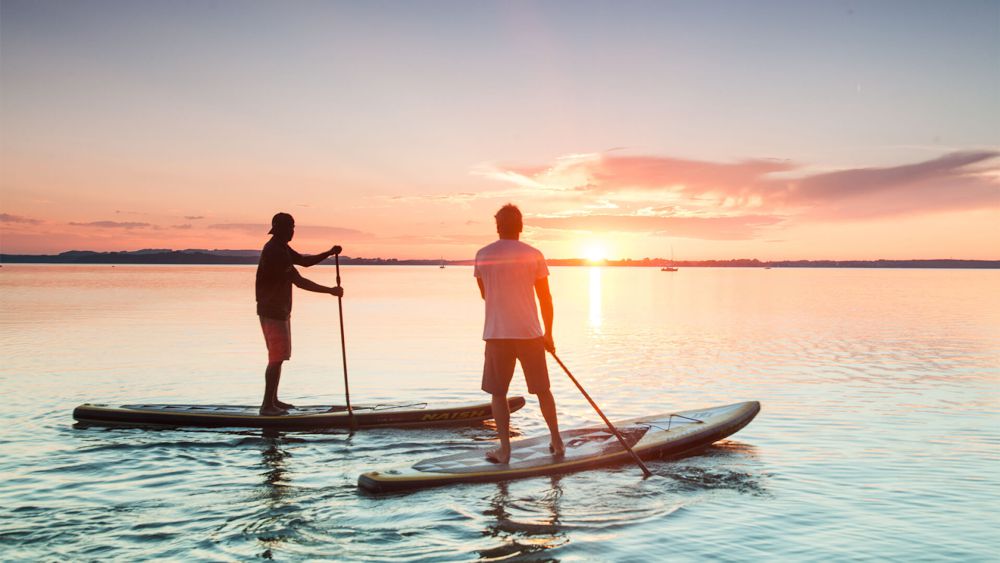
- Beginners: Opt for calm, flat water with minimal wind or current. Protected coves, lakes, or calm sections of rivers are ideal as they allow you to focus on balance and paddling techniques without the added challenge of waves or currents.
- Intermediate/Advanced Paddlers: As your skills progress, you can explore more dynamic locations. Consider gentle waves, open water with predictable currents, or calmer sections of bays, as they offer a variety of paddling experiences to hone your skills and explore further distances.
Safety Essentials
Before hitting the water, it's crucial to equip yourself for safety. Here are some safety essentials to consider for your chosen paddle board spot:
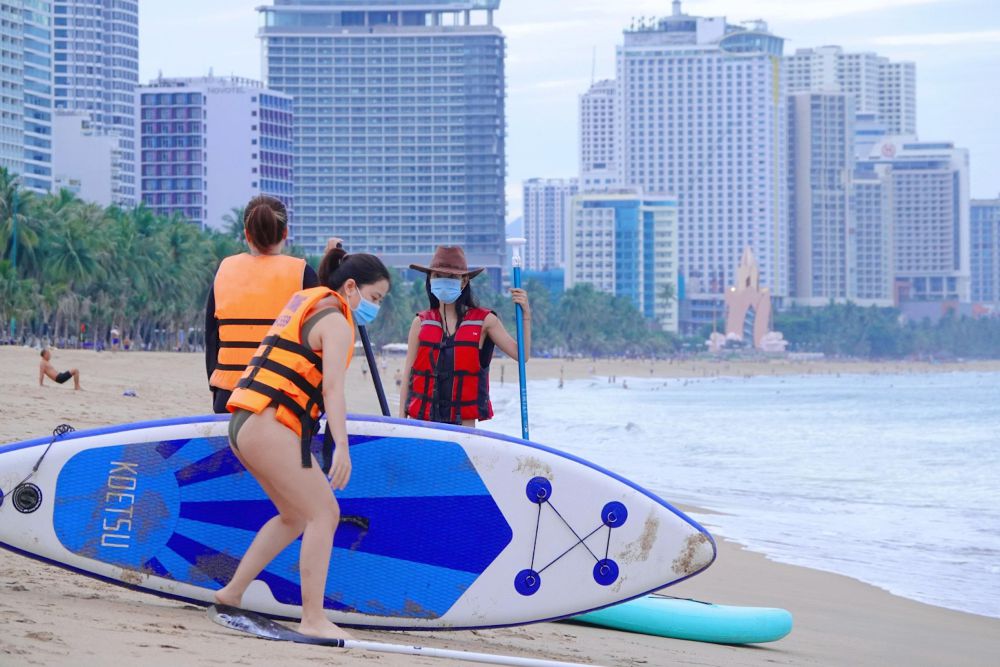
Moving Water
Calm, flat water is ideal for beginner and recreational paddle boarders. Avoid locations with strong currents, rapids, or heavy wakes from passing boats. Moving water can quickly turn a relaxing paddle into a difficult and potentially dangerous situation.
If you're unsure about the water conditions, be cautious and choose a different location.
Environmental Hazards
Be aware of your surroundings before heading out on your paddle board. Look for obstacles in the water such as rocks, submerged trees, or construction sites.
Also, watch out for wildlife that might be startled by your presence, such as aggressive fish or nesting birds. Pay attention to weather conditions; avoid paddling during thunderstorms, high winds, or extreme heat.
Rips Currents
Rip currents are powerful channels of water that flow out to sea. They can be difficult to identify and can easily pull even experienced swimmers underwater.
If you find yourself caught in a rip current, stay calm and don't fight against it. Swim parallel to the shore until you're out of the current, then paddle back to shore at an angle.
If you're unsure about rip currents or how to escape them, take a lesson from a qualified instructor.
Paddle Distance
Plan your paddling route carefully, considering your fitness level and experience. It's tempting to set off on an ambitious journey, but remember, you'll need the energy to paddle back as well.
Factor in wind and current conditions that can significantly affect your paddling effort. Always let someone know where you're going and when you expect to be back.
Safety Gear
A personal flotation device (PFD) is essential for all paddle boarders. Choose a PFD that is comfortable to wear and won't restrict your movement. A leash that connects you to your board is another crucial safety item. If you fall off in deep water, a leash will prevent your board from drifting away.
Also, consider carrying a whistle or noisemaker, and a waterproof phone case to attract attention in case of an emergency.
Community and Culture
The people and cultural experiences surrounding a paddle boarding location can significantly enhance your trip. Here's how:
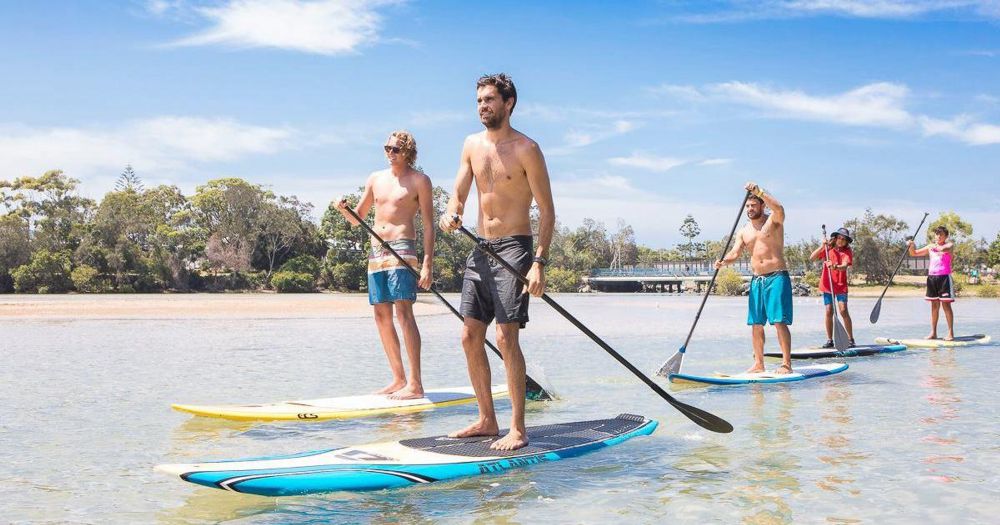
- Local knowledge and support: A welcoming community of fellow SUP enthusiasts can provide valuable insights and recommendations. Experienced local paddlers can share their favorite routes, hidden gems, and tips on navigating specific conditions. Local knowledge at your spot can elevate your paddling experience and ensure your safety on the water.
- Cultural immersion: Paddling in a location steeped in cultural significance allows you to combine your SUP adventure with a unique cultural experience. Imagine paddling past ancient temples in Southeast Asia or exploring a historic harbor town in Europe. The cultural encounters broaden your horizons and provide a deeper understanding of the local way of life.
Top 5 Paddle Board Locations in Canada
Armed with this knowledge of the ideal paddle board location, let's dive into some of the incredible spots Canada has to offer for your next stand-up paddle boarding adventure! We've compiled a list of the top five paddle board locations in Canada, catering to a variety of skill levels and preferences.
1. Lake Louise, Alberta
Nestled amidst the majestic peaks of Banff National Park, Lake Louise paddle boarding is a postcard-perfect destination renowned for its turquoise waters and stunning mountain backdrop.
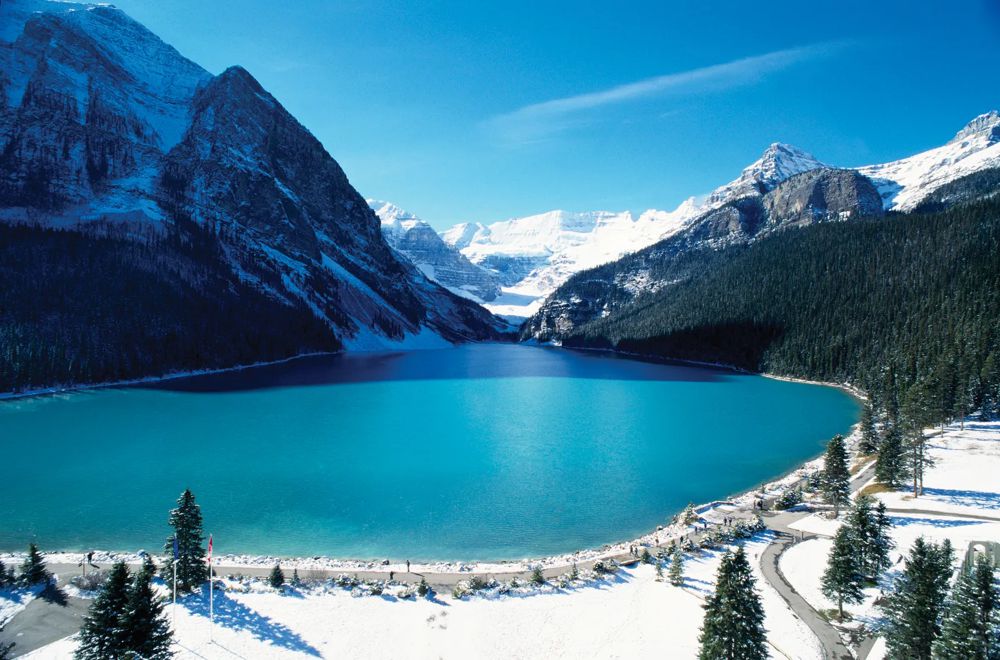
Calm conditions in the morning make it ideal for a peaceful paddle board exploration, offering a unique perspective of the iconic Fairmont Chateau Lake Louise.
- Time to get there: 1.5 hours west of Calgary (180 km)
- Water type: Lake (calm in the mornings, can be windy in the afternoons)
- Skills: Beginner to intermediate (lessons available)
- Launch point: Lakeside near the Fairmont Chateau or Moraine Lake canoe docks (seasonal)
- Amenities: Rentals, washrooms, shops, restaurants
- Costs: $20-30 per hour for board rentals, park entrance fee required (up to $20)
- Unique features: Stunning turquoise water, backdrop of Victoria Glacier and surrounding mountains, possible wildlife sightings (loons, marmots)
2. Moraine Lake, Alberta
Often overshadowed by its neighbor Lake Louise, Moraine Lake offers a more secluded and intimate paddle board experience.
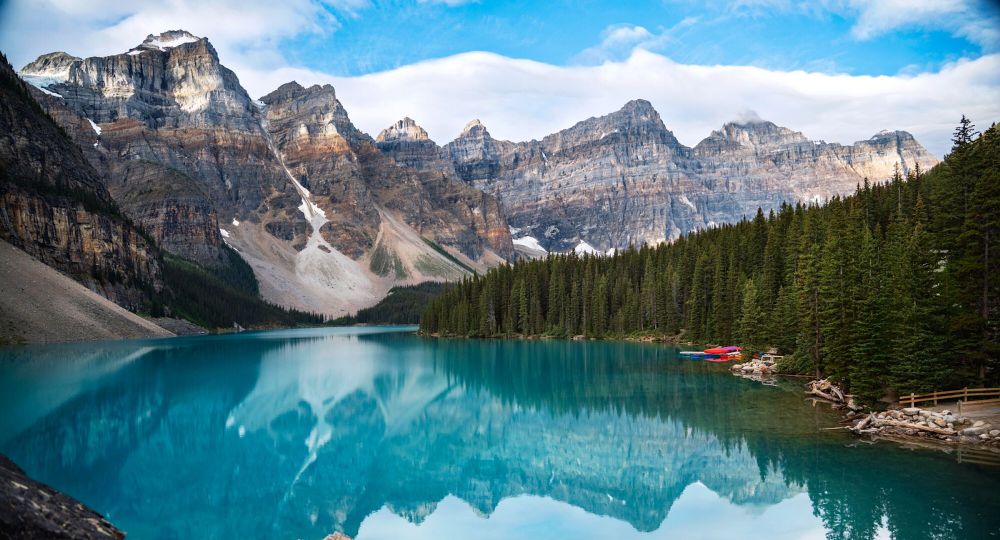
Surrounded by towering peaks and a vibrant blue glacial lake, Moraine Lake is a photographer's paradise and a haven for nature lovers.
- Time to get there: 2 hours west of Calgary (188 km)
- Water type: Lake (generally calm)
- Skills: Beginner to intermediate
- Launch point: Moraine Lake canoe docks (seasonal)
- Amenities: Rentals (limited), washrooms
- Costs: $30-40 per hour for board rentals (when available), park entrance fee ($20)
3. Algonquin Provincial Park, Ontario
Escape the urban jungle and delve into the pristine wilderness of Algonquin Provincial Park. Explore a vast network of interconnected lakes and waterways, perfect for multi-day paddle board adventures.
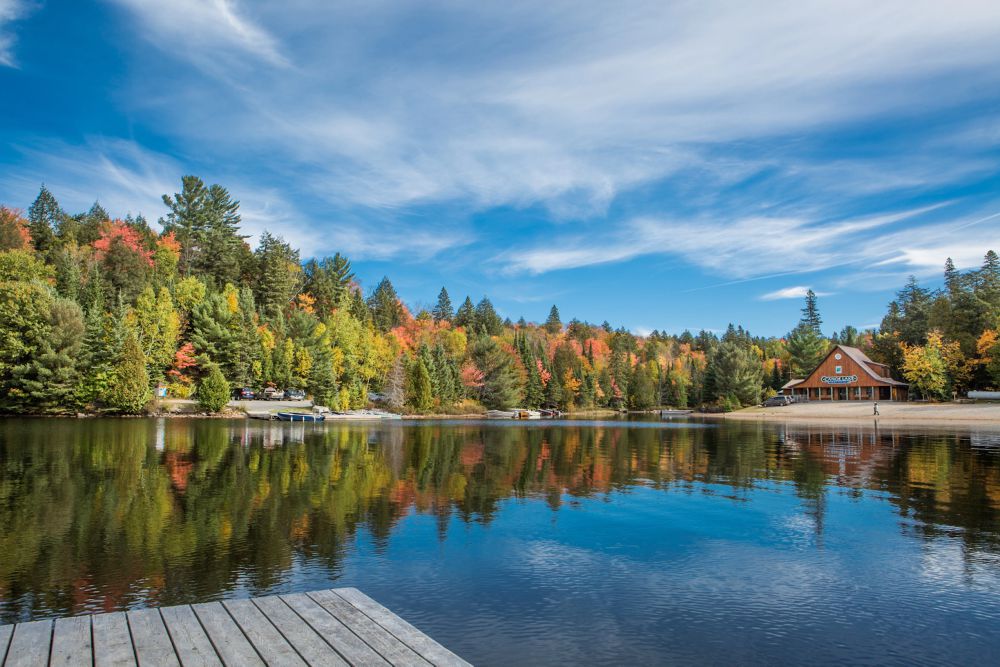
Camp on secluded islands, encounter diverse wildlife, and immerse yourself in the beauty of the Canadian Shield.
- Time to get there: 3-4 hours north of Toronto (depending on location within the park)
- Water type: Lakes, rivers (varying difficulty depending on route)
- Skills: Intermediate to advanced (guided tours available)
- Launch point: Various access points throughout the park
- Amenities: Backcountry campsites, some with basic facilities (outhouses)
- Costs: Park permit ($17.50/day), camping fees ($36.75/night), board rentals (variable)
- Unique features: Diverse wildlife (moose, beaver, loons), multi-day exploration opportunities, backcountry camping experience
4. Tofino, British Columbia
Tofino, a haven for surfers and outdoor enthusiasts, offers a unique paddle board experience on the rugged Pacific coastline.

Glide through protected inlets, explore hidden coves, and witness the untamed beauty of Clayoquot Sound. Be prepared for potential wind and ocean swells, making this a suitable location for experienced paddlers.
- Time to get there: Varies depending on departure point (Victoria: 6 hours by car and ferry, Vancouver: 4 hours by ferry and car)
- Water type: Ocean (protected inlets, exposed to wind and waves)
- Skills: Advanced (strong paddling skills and ocean awareness required)
- Launch point: Various beaches and inlets
- Amenities: Rentals, surf schools often offer SUP lessons/tours, shops, restaurants
- Costs: $40-50 per hour for board rentals, lessons/tours extra
- Unique features: Ocean paddling experience, potential for wildlife sightings (whales, seals, sea lions), explore Clayoquot Sound, witness the power and beauty of the Pacific Ocean
5. Prince Edward Island National Park, PEI
Paddle along the gentle coastline of Prince Edward Island National Park and discover a charming maritime landscape. Explore secluded beaches, red sandstone cliffs, and lush sand dunes.

The calm waters and protected coves make this a perfect location for a relaxing paddle boarding PEI adventure suitable for all skill levels.
- Time to get there: Varies depending on the departure point within the park
- Water type: Ocean (protected coves, generally calm waters)
- Skills: Beginner to intermediate
- Launch point: Various beaches within the park
- Amenities: Park facilities (washrooms, picnic areas), some beaches with concession stands
- Costs: Park entrance fee ($7.80), board rentals (variable)
- Unique features: Gentle coastline with red sandstone cliffs and sand dunes, calm and protected waters, explore PEI's natural beauty, immerse yourself in the island's rich history and culture
Unleash Your Inner Explorer with Blue Adventures
Finding the ideal paddle board location adventure requires considering various factors. The perfect spot should cater to your experience level, offer stunning scenery, and provide the amenities you desire. With careful planning and the help of resources like this guide, you can transform any body of water into your paddling paradise.
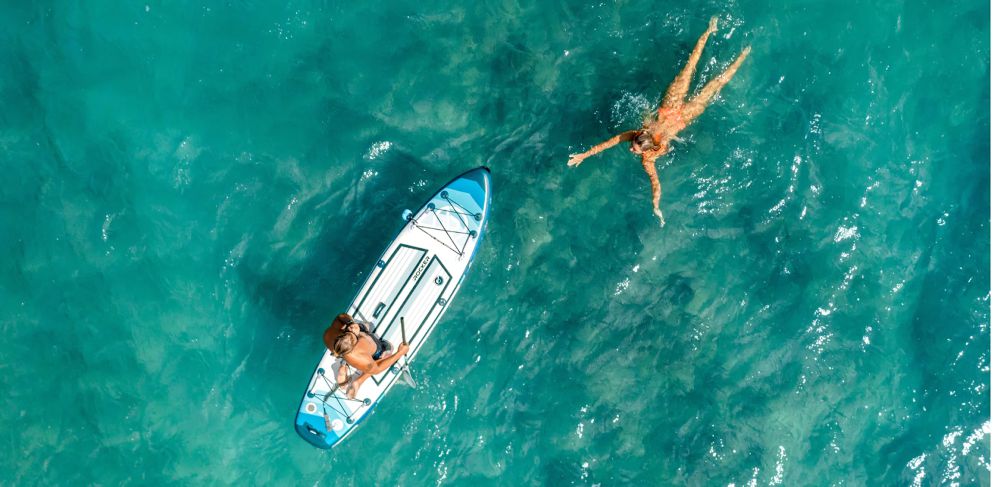
However, why limit yourself to just this guide? Dive deeper into the world of stand up paddle boarding with Blue Adventures by iROCKER! The comprehensive database of SUP locations worldwide from this app allows you to discover hidden gems, plan epic journeys, and connect with a vibrant paddling community.
Grab your favorite paddle board from iROCKER and download the Blue Adventures App today. It’s time to unlock a universe of possibilities on your next paddle board expedition!
